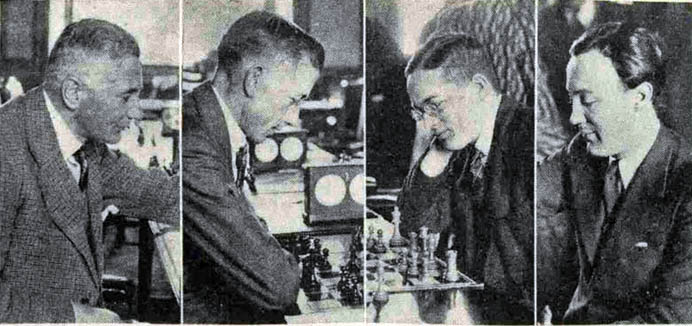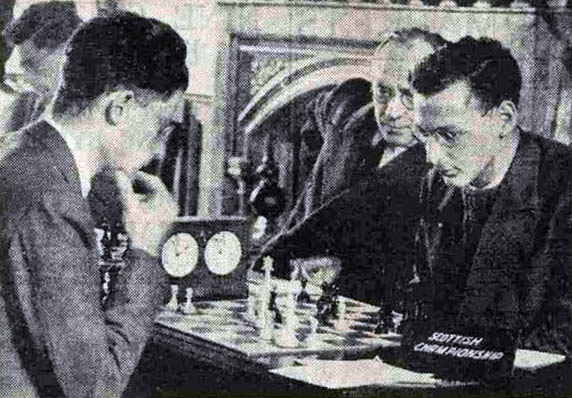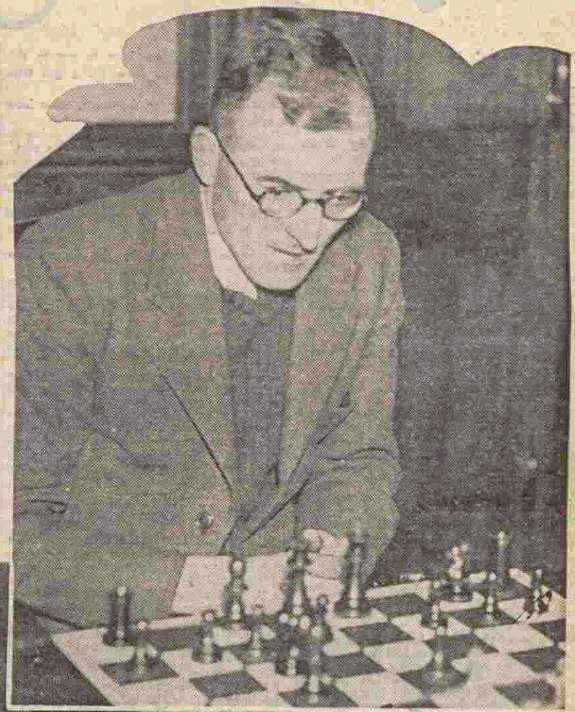 |
|
|
1939 Scottish Championship
The tournament was held during Easter, under the auspices of the Bon-Accord Chess Club, at the Education Offices, Municipal Buildings, Castlegate, Aberdeen. The local organizers of the tournament were W.R.D. McNaughton and J.E. Bothwell. Mr F.S. Teunon, President of the Scottish Chess Association and of the Bon-Accord club, opened the proceedings on the afternoon of Friday, April 7.
Left to right: WRD McNaughton, George Page, Dr JM Aitken, Robert F. Combe.
The opening day of the congress.
Aberdeen Press and Journal, Saturday, April 8, 1939, p. 10.The book of the tournament was produced and printed by Charles Pirie, Secretary of Bon-Accord Chess Club.
Max Pavey (b. 5 March 1918, Boston, USA ) was a 21–year-old student from Brooklyn , New York , who was studying medicine in Glasgow . In Chess 14 May 1939, page 342, he attributed his success to “…good ‘breaks' (white pieces against strongest players, paired against strongest players early in competition), steady play and physical endurance.” Pavey would leave Scotland soon after this tournament, in June, and would only return on one occasion, a brief stop in 1955 when he was returning from the USA v USSR match in Moscow . He died tragically young, at the age of 39, on 4 September 1957, as a result of leukemia contracted at his place of work.
At the end of round eight Pavey had 6½, followed closely by Combe and Winter, both with 6. In the final round Pavey was paired against Bernstein, while Combe and Winter had to face each other. Pavey won, while his close rivals drew.
Combe, with little opportunity for serious play, made a welcome comeback, his only loss being against the winner. He would go on to prove his real strength by winning the first post-war British Championship in 1946.
William Winter, a nephew of Scottish writer Sir James Barrie, had already indicated his willingness to represent Scotland at the 1939 Olympiad in Buenos Aires later in 1939, so perhaps he felt it was incumbent on him to play in the championship. (As it was, Scotland did not send a team to Buenos Aires because of several organizational difficulties.)
Scottish Championship 1. Pavey, M 2. Combe, RF 3. Winter, W 4. Aitken, JM 5. Perkins, NA 6. Geronimus, LH 7. Gilchrist, J 8. McNaughton, WRD 9. Page, G 10. Bernstein, N The British Chess Magazine of June 1939, p 253, stated that Winter's score was “somewhat disappointing.” Considering that he had twice won the British Championship, in 1935 and 1936, it might have been thought that Winter was the favourite to win this event.
Aitken, writing about this tournament in 1962, stated that it was his worst ever result in a Scottish Championship. He lost his first two rounds to Pavey and Combe, and drew in round three with Gilchrist. Despite scoring 5 from the last six rounds, it was not enough to pull him close to the leaders.
Perkins had a very good tournament, his only loss being to a ‘revived' Aitken in round 4. Perkins later left Scotland and ended up at Bletchley Park, the home of the codebreakers during WWII, along with Aitken. Perkins would later represent Scotland at the Munich 1958 Olympiad.
Geronimus and Bernstein, like Pavey, were also American students, both based in Edinburgh.
Gilchrist was London-based, and a great friend of Winter's. He was particularly known and respected for his chess research, a favourite area of work being the games of Emanuel Lasker.
McNaughton was from Aberdeen and, as has been noted, one of the organizers.
Page was the strong Edinburgh player who had won the Scottish championship in 1925, and represented Scotland in the Olympiads at Folkestone 1933 and Stockholm 1937.
Here is Pavey's opening round win against Dr Aitken.
Dr J.M. Aitken - M. Pavey
Scottish Championship, Aberdeen (1) 19391 e4 c5 2 Nf3 d6 3 d4 cxd4 4 Nxd4 Nf6 5 f3 Aitken's favourite. The usual move of course is Nc3. This move has for its purpose the formation of P on K4 and P on QB4 against which Black is fairly well hampered. Its weak point is that it is artificial and Black can force P-Q4 by correct timing to achieve a better game. 5...e5 6 Nb5 a6 [6 ..d5 loses to 7 exd5 Nxd5 8 Qxd5 Qxd5 9 Nc7+] 7 N5c3 Be6 8 Nd5 Nxd5 9 exd5 Bf5 10 Be3 Causes White to be weakened. 10 Bd3 would be followed by 10 ..Qh4+ 11 g3 Qh3 giving Black the upper hand. 10...Qh4+ 11 Kd2 11 Bf2 or; 11 g3 Qb4+ wins a pawn 11 ..Nd7 Quiet development is in order here. 11...Qb4+ gives nothing. 12 c4 Be7 13 Qe1 Qxe1+ No better way of taking advantage of the position; the alternative 13 ..Qf6 to avoid exchange crowds Black's pieces too much to be of any use. Here at any rate White cannot castle and is behind in development. 14 Kxe1 0–0 15 Nc3 Rfc8 16 Ne4 b5 17 Rc1 17 cxb5 axb5 18 Bxb5 Rab8 and White's pawns fall 19 Ng3 Bh4 with a won position 17 ..Bxe4 18 fxe4 Nf6 19 cxb5 Rxc1+ 20 Bxc1 axb5 21 Bxb5 Here 21 a3 loses by 21 ..Rc8 and either ...Rc2 or ...Nxe4 as the next move is made would be decisive. 21 ..Rxa2 22 Kd2 Black must win a pawn for if 22 Bd3 Ra4. 22 ..Nxe4+ 23 Kc2 f5 24 Kb1 Ra5 25 Bc6 By far the best. Black is quite uncomfortable owing to his hampered Bishop and the threat of b4 and Be3 is almost deadly. 25 ..f4 The Bishop must not reach e3. 26 Re1 Nf6 27 b4 27 Bxf4 fails by 27 ..Nxd5 28 Bd2 Rc5. 27...Ra7 28 Bd2 Bd8 29 b5 Kf7 30 Re2 Nd7 Answers the threat of Bb4 adequately because after ...Ke7, Bxd7 is answered by ...Kxd7. Black must avoid an exchange of White's black Bishop for his N as opposite-coloured bishops with a pawn ahead is frequently no better than a draw. 31 Bb4 Ke7 32 Kb2 Bb6 33 Kb3 Rc7 34 Kc4 g5 35 Kd3 Bc5 36 Bxc5 Nxc5+ 37 Kc4 e4 38 Kd4 It is interesting that 38 b6 leads to nothing by 38 ..Rc8 39 b7 Rb8 40 Ra2 Kd8 41 Ra8 Kc7. 38 ..e3 Black places a passed pawn in a threatening position since the rook is the only piece to stop it. 39 g3 Kf6 Black recognises that White can do nothing and he intends playing ...Kf5-g4-f3 etc. This quiet move forces White's hand and leads to a speedy finish. 40 h4 h6 41 Be8 Nb3+ Wins the exchange. 42 Ke4 Rc4+ 43 Kd3 Rc8 The object of the checks. 44 hxg5+ hxg5 45 Bh5 Nc1+ 46 Ke4 Rc4+ 47 Kf3 Nxe2 48 Kxe2 Rb4 49 gxf4 gxf4 0–1
Bernstein - Pavey (right), in the final round. Position after Black's 27th move.
Aberdeen Press and Journal, Friday, April 14, 1939, p. 9.
N. Bernstein - M. Pavey
Scottish Championship, Aberdeen (9) 19391. c4 Nc6 2. g3 e5 3. Bg2 Nf6 4. d3 Bc5 5. Nf3 O-O 6. O-O d6 7. Nc3 Bg4 8. Nd2
Qc8 9. Nf3 Bh3 10. Be3 Bxe3 11. fxe3 Bxg2 12. Kxg2 Ng4 13. Qd2 f5 14. Nh4 Qe6
15. h3 Nh6 16. e4 f4 17. gxf4 Qf6 18. Nf5 Nxf5 19. exf5 Qxf5 20. e4 Qg6+ 21.
Kh2 Qh6 22. Nd5 Rf7 23. Qe3 Raf8 24. f5 Qxe3 25. Nxe3 Nd4 26. Rf2 g6 27. Rg2
Kg7 28. Kh1 Kf6 29. fxg6 hxg6 30. Rag1 Rh8 31. Nd5+ Ke6 32. Rxg6+ Kd7 33. Kh2
Nf3+ 34. Kg2 Nxg1 35. Kxg1 Rxh3 36. Nf6+ Kc6 37. Ng4 Kc5 38. Kg2 Rxd3 0-1In the Scottish Chess Association Bulletin number 13 of January-May 1964, G.D. Campbell, who played in the Boys' Championship, reminisced about the congress:
Ladies' Championship
Ladies' Championship 1939 1 2 3 4 5 6 Pts 1. Mrs Brockett 1 ½ 0 1 ½ 1 4 2. Miss Forbes 0 ½ 1 0 ½ 0 2 Major
Major Tournament 1939 1 2 3 4 5 6 Pts 1. P.B. Anderson ■ 1 1 ½ ½ 1 4 2. J.E. Bothwell 0 ■ 1 1 1 1 4 3. R.D. Dykes 0 0 ■ 1 0 1 2 4. H.D. Gemmell ½ 0 0 ■ 1 ½ 2 5. V. Rush ½ 0 1 0 ■ ½ 2 6. R. Morrison 0 0 0 ½ ½ ■ 1 The Major resulted in a tie between P.B. Anderson (Glasgow) and J.E. Bothwell (Aberdeen). R. Morrison of Edinburgh was blind.
J.E. Bothwell
Photo: People's Journal, 15 April 1939Boys' Championship
Boys' Championship 1939 1 2 3 4 5 6 7 Pts 1. G. Piercy ■ ½ 1 1 1 1 1 5½ 2. G.D. Campbell ½ ■ 1 1 1 1 1 5½ 3. J. Semple 0 0 ■ 1 1 1 1 4 4. J.R. Mackenzie 0 0 0 ■ 0 1 1 2 5. C. Milne 0 0 0 1 ■ 0 1 2 6. A. Murphy 0 0 0 0 1 ■ 1 2 7. G. Milne 0 0 0 0 0 0 ■ 0
Gerald Piercy of Glasgow won the play-off game to secure his third consecutive win in the event. The other six competitors were all from Aberdeen.
Alan McGowan
Historian/Archivist, Chess Scotlandupdated 28/4/2021


 campbell.jpg)
 campbell.jpg)
